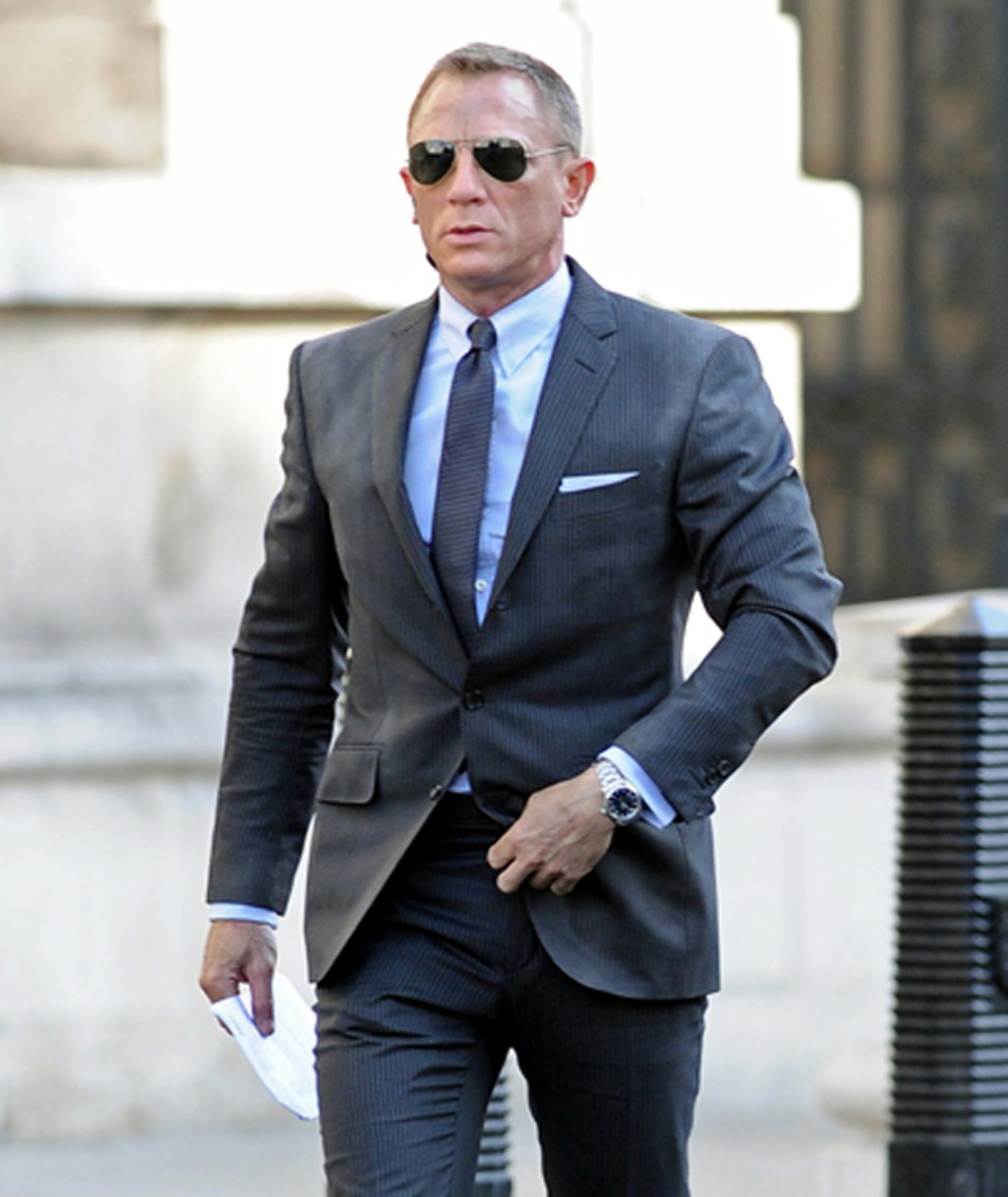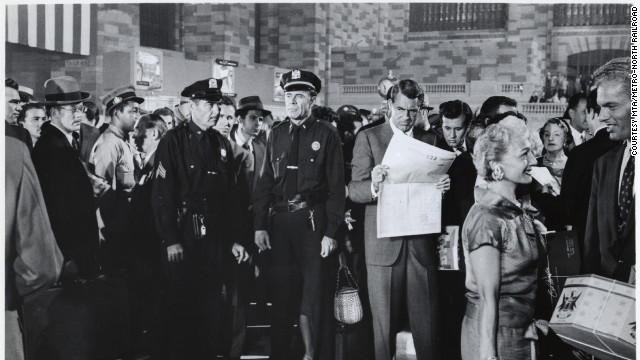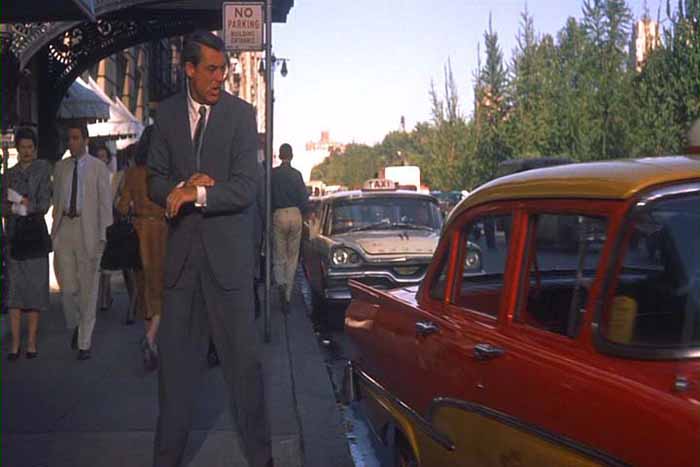Cary Grant's suit design
Posted: Sat Aug 10, 2013 12:09 am
How did Cary Grant design a suit to look like this?

There are many ways of dressing beautifully. But even if our tastes differ from his, it's worthwhile to think about why he made certain design choices. Edith Head, who won the Academy Award for costume design eight times, commented that Grant has "a discerning eye, a meticulous sense of detail. He has the greatest fashion sense of any actor I've ever worked with." Grant himself said that "it takes 500 small details to add up to one favorable impression." Why did he choose the details that he did?
I would say, looking at the photo, that his design principle was to ensure that the jacket flowed smoothly into the trousers, to unify the whole suit into a single unbroken line. What's extraordinary is that we can barely tell where the jacket ends and the trousers begin. The eye sweeps from top to bottom in an elegant impression of height and grace.
It sounds easy, as easy as making sure that the jacket fabric matches the trousers, but in reality it's overwhelmingly difficult. There are many places to stop the eye, to break the line from shoulder to shoe. So how did he do it?
The main point of difficulty in a suit is where the wider jacket meets the narrower trouser. The difference in scale can break up the suit into two visual parts. The eye stops at the jacket bottom and the body is divided into half, as in Hilfiger's suit:

Grant's secret was to make the jacket bottom trimmer at the same time that he made the trouser tops wider. It was an ingenious move: usually wider trousers are paired with an excessively large jacket, as in the 1980s. If the jacket is slim, then the trousers are too tight, as is the trend today. Either way, a horizontal gap remains where the jacket and trousers meet:
The 1980s:

Today:

Grant's masterstroke was to cut the bottom of the jacket close to the thigh, while the top of the trousers were fuller and pleated. The result was to preserve to smooth flow between the two halves of the suit. This explains what would otherwise be puzzling decisions on Grant's part. Why did he choose pleated pants when the Ivy League look at the time preferred flat-front? It was to scale up the top of the trousers, so there would be no horizontal gap with the jacket. Why did he select a ventless jacket? It was to make it possible to cut the jacket bottom closer to the thigh without having any vents swinging open. Why was the jacket darted when in the late 1950s most American jackets were undarted? It was to taper the jacket down to meet the trousers.

Despite the jacket being tapered, it was nothing like the slim jackets of today with their low-rise pants. Many contemporary designers break up the suit by making the jacket too short and the trousers too low. This opens up a distracting vertical gap, showing the dress shirt between the jacket's fastening button and the waistband:

Grant closed this vertical gap, preserving the smooth line of his suit. He brought up the trouser waist with a higher-rise, while lengthening the jacket. There's no glimpse of dress shirt to stop the eye:

The length of the suit is more flattering than today's short jackets, as worn by Craig and Browne. These modern jackets make the eye dwell on the top of the body, as if we were looking at a windbreaker. Grant's longer jacket leads the eye up and down the entire silhouette of the suit.
When Grant united the jacket and trousers, he tapered the whole suit from moderately built up shoulders down to a trim leg opening. The profile is a trapezoid, and the effect is masculine:



The trapezoid shape was one of Grant's design breakthroughs. Since the suit tapered, it prevents the jacket from looking boxy, or the trousers from looking like Oxford bags. He further streamlines the silhouette by replacing a bulky belt (like Hilfiger's above) with side adjusters, and pocket flaps with jetted pockets.
The trapezoid shape is quite distinct, as it differs from today's common hourglass shape. The hourglass suppresses the waist to bring attention to a slender torso and strong shoulders:

Done well, it can look sophisticated and attractive. Why didn't Grant suppress the waist more? He wanted to preserve the trapezoid shape. If the waist were suppressed more, the jacket would have to flare out in the bottom half (the skirt) to cover the hips. The line of the flared out jacket would not have met the line of the trouser. A suppressed waist also tends to draw attention to the narrow part of the jacket, instead of letting the eye move up and down the whole suit
The trapezoid shape could have gone awry if the shoulders were too broad, as in Richard Gere's 1980s suit. Grant prevented that from happening by having a shoulder that is built up, but moderately so. It's not cut too wide or too straight.
Moderation was a central design principle for Grant. Moderation helps unify the suit by making sure that the eye does not stop on any one element. That is why Grant choose labels that were three and half inches wide, and not five or two. That is why Grant selected a natural sleevehead, and not a roped one. That is why he matched his color of his tie with his suit. He wanted the eye to sweep over the whole suit without dwelling on any one part.
Not too bad for suits that many people call "boring."

There are many ways of dressing beautifully. But even if our tastes differ from his, it's worthwhile to think about why he made certain design choices. Edith Head, who won the Academy Award for costume design eight times, commented that Grant has "a discerning eye, a meticulous sense of detail. He has the greatest fashion sense of any actor I've ever worked with." Grant himself said that "it takes 500 small details to add up to one favorable impression." Why did he choose the details that he did?
I would say, looking at the photo, that his design principle was to ensure that the jacket flowed smoothly into the trousers, to unify the whole suit into a single unbroken line. What's extraordinary is that we can barely tell where the jacket ends and the trousers begin. The eye sweeps from top to bottom in an elegant impression of height and grace.
It sounds easy, as easy as making sure that the jacket fabric matches the trousers, but in reality it's overwhelmingly difficult. There are many places to stop the eye, to break the line from shoulder to shoe. So how did he do it?
The main point of difficulty in a suit is where the wider jacket meets the narrower trouser. The difference in scale can break up the suit into two visual parts. The eye stops at the jacket bottom and the body is divided into half, as in Hilfiger's suit:

Grant's secret was to make the jacket bottom trimmer at the same time that he made the trouser tops wider. It was an ingenious move: usually wider trousers are paired with an excessively large jacket, as in the 1980s. If the jacket is slim, then the trousers are too tight, as is the trend today. Either way, a horizontal gap remains where the jacket and trousers meet:
The 1980s:

Today:

Grant's masterstroke was to cut the bottom of the jacket close to the thigh, while the top of the trousers were fuller and pleated. The result was to preserve to smooth flow between the two halves of the suit. This explains what would otherwise be puzzling decisions on Grant's part. Why did he choose pleated pants when the Ivy League look at the time preferred flat-front? It was to scale up the top of the trousers, so there would be no horizontal gap with the jacket. Why did he select a ventless jacket? It was to make it possible to cut the jacket bottom closer to the thigh without having any vents swinging open. Why was the jacket darted when in the late 1950s most American jackets were undarted? It was to taper the jacket down to meet the trousers.

Despite the jacket being tapered, it was nothing like the slim jackets of today with their low-rise pants. Many contemporary designers break up the suit by making the jacket too short and the trousers too low. This opens up a distracting vertical gap, showing the dress shirt between the jacket's fastening button and the waistband:

Grant closed this vertical gap, preserving the smooth line of his suit. He brought up the trouser waist with a higher-rise, while lengthening the jacket. There's no glimpse of dress shirt to stop the eye:

The length of the suit is more flattering than today's short jackets, as worn by Craig and Browne. These modern jackets make the eye dwell on the top of the body, as if we were looking at a windbreaker. Grant's longer jacket leads the eye up and down the entire silhouette of the suit.
When Grant united the jacket and trousers, he tapered the whole suit from moderately built up shoulders down to a trim leg opening. The profile is a trapezoid, and the effect is masculine:



The trapezoid shape was one of Grant's design breakthroughs. Since the suit tapered, it prevents the jacket from looking boxy, or the trousers from looking like Oxford bags. He further streamlines the silhouette by replacing a bulky belt (like Hilfiger's above) with side adjusters, and pocket flaps with jetted pockets.
The trapezoid shape is quite distinct, as it differs from today's common hourglass shape. The hourglass suppresses the waist to bring attention to a slender torso and strong shoulders:

Done well, it can look sophisticated and attractive. Why didn't Grant suppress the waist more? He wanted to preserve the trapezoid shape. If the waist were suppressed more, the jacket would have to flare out in the bottom half (the skirt) to cover the hips. The line of the flared out jacket would not have met the line of the trouser. A suppressed waist also tends to draw attention to the narrow part of the jacket, instead of letting the eye move up and down the whole suit
The trapezoid shape could have gone awry if the shoulders were too broad, as in Richard Gere's 1980s suit. Grant prevented that from happening by having a shoulder that is built up, but moderately so. It's not cut too wide or too straight.
Moderation was a central design principle for Grant. Moderation helps unify the suit by making sure that the eye does not stop on any one element. That is why Grant choose labels that were three and half inches wide, and not five or two. That is why Grant selected a natural sleevehead, and not a roped one. That is why he matched his color of his tie with his suit. He wanted the eye to sweep over the whole suit without dwelling on any one part.
Not too bad for suits that many people call "boring."










